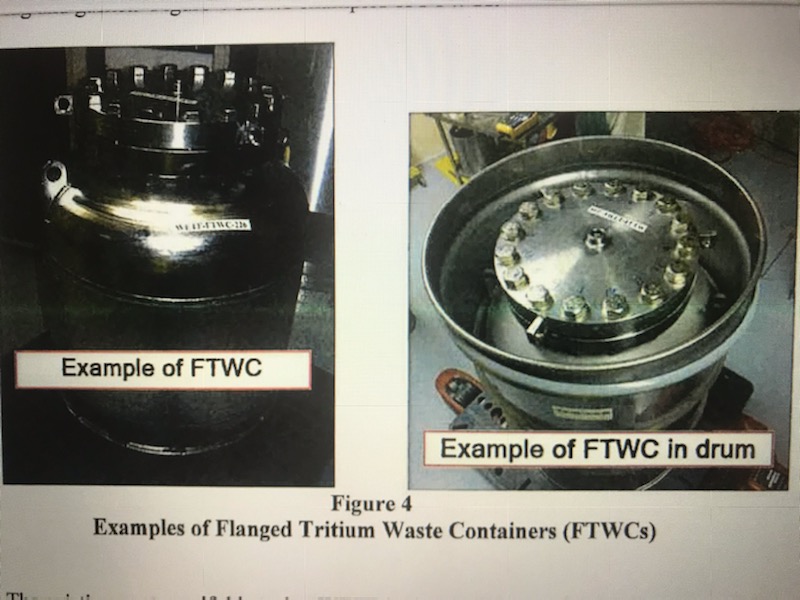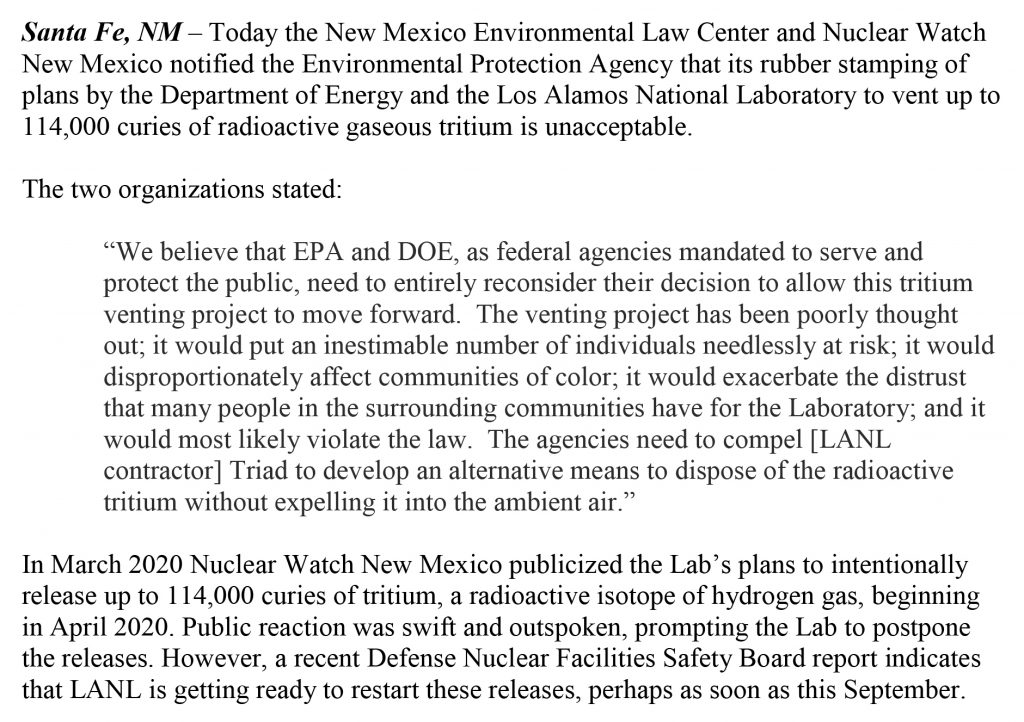Environment Secretary Says LANL Tritium Venting Project Puts New Mexico In Bad Situation
“Under the Triad contract, one of their performance requirements for this fiscal year is to vent five more containers that are larger, that contain more tritium, by Sept. 30. So we feel like they’re trying to get permission to vent these four containers on Friday so that they can vent the other five before the end of the fiscal year so that they can get their bonus…This is a pattern in practice by DOE – to do things in order to get the bonuses for their contractors.” – Joni Arends, executive director of Concerned Citizens for Nuclear Safety
BY: MAIRE O’NEILL | losalamosreporter.com
The planned venting of tritium from four Flanged Tritium Waste Containers at Los Alamos National Laboratory on or after Friday, Sept. 11 has placed the state of New Mexico in a bad situation, New Mexico Environment Department (NMED) Sec. James Kenney told the Legislature’s Committee on Radioactive and Hazardous Materials Wednesday.
The Los Alamos Reporter previously published two stories on the venting project:
https://losalamosreporter.com/2020/03/23/lanl-to-conduct-tritium-venting-operation-beginning-in-april/
https://losalamosreporter.com/2020/04/03/lanl-tritium-ventilation-project-on-hold-due-to-covid-19-scope-of-work-amended-to-include-possible-secondary-venting/
“These containers have been neglected for so long by both DOE and the Environment Department. We’re in this position, which is do they vent those tritium drums, collect that emission to prevent it from being in the air and then move those drums offsite, or do we run the risk of leaving those drums onsite knowing that they are pressurized and could rupture meaning an uncontrolled amount of tritium would go out,” Kenney said. “I do not like the position our Department is in. I think this goes towards the fact that DOE did not do something sooner and it goes to the fact that our Department has been so underfunded that we don’t have the staff to go and hold people accountable to do those things in a timely manner, so we are in a very bad position.”
LANL Tritium Ventilation Project On Hold Due To COVID-19, Scope Of Work Amended To Include Possible Secondary Venting
ARTICLE BY: MAIRE O’NEILL | losalamosreporter.com

Los Alamos National Laboratory has notified the Environmental Protection Agency that plans for venting four flanged tritium waste containers (FTWCs) at Technical Area 54 have been finalized with an amended scope of work. However, according to NNSA Los Alamos Field Office spokesperson Toni Chiri, the operations, originally slated for this month, have been postponed due to COVID -19 and won’t be executed until the Laboratory is able to support the activity with a full complement of operational personnel.
LANL set to release radioactive vapors
Los Alamos National Laboratory will release radioactive vapors into the atmosphere to ventilate several barrels of tritium-tainted waste generated during the Cold War. Jay Coghlan, executive director of Nuclear Watch New Mexico, said in the 1990s he won a lawsuit against the Energy Department for falsely claiming a building’s “shielding factor” kept radioactive emissions within federal limits.
“The undocumented assertion in the application that half of the tritium could remain behind in equipment should be viewed with suspicion,” Coghlan said.
ARTICLE BY: SCOTT WYLAND | santafenewmexican.com
The lab informed the U.S. Environmental Protection Agency earlier this month that it would ventilate four waste containers, beginning April 17, to relieve the built-up, radioactive hydrogen in the barrels’ headspace to prevent them from rupturing while they’re being handled. The EPA approved the application for the radioactive release last year.
More Information on Tritium’s Significant Hazards
Routine Radioactive Releases from U.S. Nuclear Power Plants. An update to our comprehensive list and map of all operating U.S. reactors and where they release radioactivity into the air and water. Every nuclear power reactor dumps radioactive water, scatters radioactive particles, and disperses radioactive gases as part of its routine, everyday operation. It doesn’t take an accident. Federal regulations permit these radioactive releases. Any exposure to radiation increases the risk of damage to tissues, cells, DNA, and other vital molecules, potentially causing genetic mutations, cancers, leukemias, birth defects, and reproductive, cardiovascular, endocribe, and immune system disorders.
The pamphlet lists all reactors operating at the October 2015 press time. For an up to date track of reactors as they close, please visit our Reactors Are Closing page
[This pamphlet is broader than just tritium, but tritium plays a significant part. See especially the discussion of how hazardous even a couple of curies of hazardous radioactivity, badly handled, can be.]
Reports
Leak First, Fix Later: Uncontrolled and Unmonitored Radioactive Releases from Nuclear Power Plants
UPDATED!
Leak First, Fix Later: Uncontrolled and Unmonitored Radioactive Releases from Nuclear Power Plants. May 2015. Newly revised and updated from the original, Leak First is a Beyond Nuclear report on the persistent and ongoing leaking of radioactive effluent into ground and surface water from uninspected and unmaintained buried piping under every nuclear power plant.
UPDATED!
Executive Summary. May 2015.
Note: New leaks occur often and at multiple nuclear reactor sites. Watch this page for updates on new leaks and spills.
On March 11, the Los Alamos National Laboratory (LANL) sent the federal Environmental Protection Agency (EPA) a formal notice that the Lab will intentionally release up to some 100,000 curies of tritium, a radioactive isotope of hydrogen gas, beginning April 17, 2020.
This massive radioactive venting is due to take place as northern New Mexico begins to grapple with the COVID-19 pandemic, and places a further burden on some of our most vulnerable and at-risk communities. At the same time DOE is ramping up nuclear weapons production and plans to cut cleanup at LANL nearly in half.
NUKEWATCH PRESS RELEASE
[embeddoc url="https://nukewatch.org/wp-content/uploads/2020/03/NukeWatchNM-tritium-PR-3-19-20.pdf" download="all" viewer="browser"]
BACKGROUND INFORMATION
- LANL Set to Release Radioactive Vapors, Santa Fe New Mexican, March 23, 2020
- LANL Plans to Release Twice the Amount of Tritium Allowed from Concerned Citizens for Nuclear Safety (CCNS)




